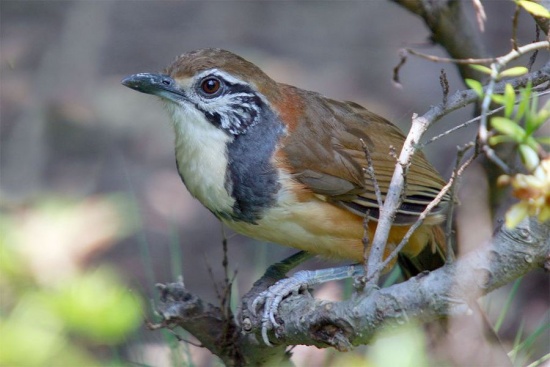| Line 11: | Line 11: | ||
Clements<sup>[[#References|2]]</sup> accepts seven subspecies: | Clements<sup>[[#References|2]]</sup> accepts seven subspecies: | ||
*''G. p. pectoralis'' in the [[Himalayas]] from [[Nepal]] to [[China]] | *''G. p. pectoralis'' in the [[Himalayas]] from [[Nepal]] to [[China]] | ||
| − | *''G. p. melanotis'' in the [[Himalayas]] from [[Sikkim]], [[Assam]] and [[Myanmar]] to S [[China]], also sometimes merged with nominate.<sup>[[#References|1]]</sup> | + | *''G. p. melanotis'' in the [[Himalayas]] from [[Sikkim]], [[Assam]] and [[Myanmar]] to S [[China]], also sometimes merged with nominate.<sup>[[#References|1]], [[#References|3]]</sup> |
*''G. p. pingi'' in S [[China]]. This form is also treated as hybrid between nominate and ''robini''.<sup>[[#References|1]]</sup> | *''G. p. pingi'' in S [[China]]. This form is also treated as hybrid between nominate and ''robini''.<sup>[[#References|1]]</sup> | ||
*''G. p. subfusus'' in SE [[Myanmar]], [[Thailand]] and NW [[Laos]] | *''G. p. subfusus'' in SE [[Myanmar]], [[Thailand]] and NW [[Laos]] | ||
| Line 20: | Line 20: | ||
Found in broadleaf evergreen forest, mixed deciduous forest and mixed broadleaf-coniferous forest. Also in secondary growth, bamboo and plantations. Recorded up to 1830m, occasionally to 2000m.<sup>[[#References|1]]</sup> | Found in broadleaf evergreen forest, mixed deciduous forest and mixed broadleaf-coniferous forest. Also in secondary growth, bamboo and plantations. Recorded up to 1830m, occasionally to 2000m.<sup>[[#References|1]]</sup> | ||
==Behaviour== | ==Behaviour== | ||
| + | Feeds mostly on insects and fruits. Often found in large flocks, up to 25 birds and often associated with [[White-crested Laughingthrush]] and [[Lesser Necklaced Laughingthrush]], also with [[Green Magpie]] and [[Greater Racket-tailed Drongo]] <sup>[[#References|1]],[[#References|3]]</sup><br/ > | ||
| + | Breeding season from February to August. The nest is placed from ground-level up to about 6m in a bush, a small tree, bamboo or sometimes among grass. It's a large and bulky shallow cup made with dead bamboo, leaves, moss and twigs. Lays 3 to 7 eggs. Brood parasitism by [[Chestnut-winged Cuckoo]] recorded.<sup>[[#References|1]]</sup><br/ > | ||
| + | Resident species, no movements known.<sup>[[#References|1]]</sup> | ||
==Reference== | ==Reference== | ||
# del Hoyo, J., Elliott, A. and Christie, D.A. eds. 2007. ''Handbook of the Birds of the World. Vol. 12. Picathartes to Tits and Chickadees''. Barcelona: Lynx Edicions. ISBN 84-96553-42-6 | # del Hoyo, J., Elliott, A. and Christie, D.A. eds. 2007. ''Handbook of the Birds of the World. Vol. 12. Picathartes to Tits and Chickadees''. Barcelona: Lynx Edicions. ISBN 84-96553-42-6 | ||
# Clements James F. 2007. ''The Clements Checklist of Birds of the World''. 6th ed., with updates to October 2007. Ithaca: Cornell University Press. ISBN 9780801445019 | # Clements James F. 2007. ''The Clements Checklist of Birds of the World''. 6th ed., with updates to October 2007. Ithaca: Cornell University Press. ISBN 9780801445019 | ||
| + | # Rasmussen, P.C. and Anderton, J.C. 2005. ''Birds of South Asia''. The Ripley Guide. Washington D.C. and Barcelona: Smithsonian Institution and Lynx Editions. ISBN 84-87334-67-9 | ||
==External Links== | ==External Links== | ||
{{GSearch|Garrulax+pectoralis}} | {{GSearch|Garrulax+pectoralis}} | ||
[[Category:Birds]] [[Category:Garrulax]] | [[Category:Birds]] [[Category:Garrulax]] | ||
Revision as of 12:33, 4 August 2008
Alternative names: Black-gorgeted Laughingthrush; Necklaced Laughingthrush; Gorgeted Laughingthrush
- Garrulax pectoralis
Identification
Distribution
Found in SE-Asia from the Himalayas (Nepal, India, Bhutan) to Myanmar, S to Thailand, Laos and Vietnam and east through S China, including Hainan.1
Common in parts of its range and not globally threatened.1
Taxonomy
Clements2 accepts seven subspecies:
- G. p. pectoralis in the Himalayas from Nepal to China
- G. p. melanotis in the Himalayas from Sikkim, Assam and Myanmar to S China, also sometimes merged with nominate.1, 3
- G. p. pingi in S China. This form is also treated as hybrid between nominate and robini.1
- G. p. subfusus in SE Myanmar, Thailand and NW Laos
- G. p. robini in S China, N Vietnam and NE Laos
- G. p. picticollis in E China
- G. p. semitorquatus on Hainan.
Habitat
Found in broadleaf evergreen forest, mixed deciduous forest and mixed broadleaf-coniferous forest. Also in secondary growth, bamboo and plantations. Recorded up to 1830m, occasionally to 2000m.1
Behaviour
Feeds mostly on insects and fruits. Often found in large flocks, up to 25 birds and often associated with White-crested Laughingthrush and Lesser Necklaced Laughingthrush, also with Green Magpie and Greater Racket-tailed Drongo 1,3
Breeding season from February to August. The nest is placed from ground-level up to about 6m in a bush, a small tree, bamboo or sometimes among grass. It's a large and bulky shallow cup made with dead bamboo, leaves, moss and twigs. Lays 3 to 7 eggs. Brood parasitism by Chestnut-winged Cuckoo recorded.1
Resident species, no movements known.1
Reference
- del Hoyo, J., Elliott, A. and Christie, D.A. eds. 2007. Handbook of the Birds of the World. Vol. 12. Picathartes to Tits and Chickadees. Barcelona: Lynx Edicions. ISBN 84-96553-42-6
- Clements James F. 2007. The Clements Checklist of Birds of the World. 6th ed., with updates to October 2007. Ithaca: Cornell University Press. ISBN 9780801445019
- Rasmussen, P.C. and Anderton, J.C. 2005. Birds of South Asia. The Ripley Guide. Washington D.C. and Barcelona: Smithsonian Institution and Lynx Editions. ISBN 84-87334-67-9




